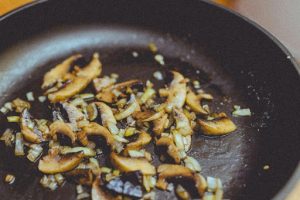“Experience hassle-free, healthy cooking with our high-quality non-stick frying pans. Perfect for effortless meals!”
A quality non stick frying pan ensures effortless cooking and easy cleanup, minimises food sticking, promotes healthier meals with less oil usage, and enhances overall culinary experiences by providing even heat distribution. It is a versatile kitchen essential that makes cooking and cleanup easier.
Here are some key features and benefits of using a non-stick frying pan:
1. Easy Cooking
The non-stick coating prevents food from sticking, allowing for smoother cooking experiences. This primarily benefits delicate items like eggs, pancakes, and fish.
2. Healthier Cooking
Less oil or butter is required when using a non-stick frying pan, which can lead to healthier meal preparation. This is particularly useful for those looking to reduce fat intake.
3. Effortless Cleanup
Cleaning a non-stick frying pan is quick and easy, as food residue comes off with minimal scrubbing. Most are dishwasher-safe, although hand washing is often recommended to prolong their lifespan.
4. Lightweight and Easy to Handle
Non-stick frying pans are generally lighter than traditional cast iron or stainless steel pans, making them easier to manoeuvre and handle.
5. Variety of Sizes and Styles
These pans come in various sizes and designs, making it easy to find one that fits your cooking style and kitchen needs.
6. Heat Distribution
Many non-stick frying pans are designed with materials that promote even heat distribution, helping to prevent hot spots and ensuring food cooks uniformly.

Considerations When Choosing a Non-Stick Frying Pan
- Material: Look for high-quality non-stick coatings like ceramic or titanium, which tend to be more durable and resistant to scratching.
- Compatibility: Ensure the pan matches your stovetop type (gas, electric, or induction).
- Temperature Limitations: Check the manufacturer’s guidelines for maximum heat settings, as some non-stick coatings can degrade at high temperatures.
- Care Instructions: Follow proper care and maintenance to extend the life of the non-stick surface; using silicone or wooden utensils can help prevent scratches.
Factors to Consider When Choosing a High-quality Non-Stick Frying Pan
- Material of the Non-Stick Coatings:
Look for pans made with durable coatings like ceramic or titanium, known for their resilience and resistance to scratches. Avoid pans with cheap coatings that can wear off quickly. - Heat Resistance:
Check the frying pan’s maximum heat tolerance. High-quality non-stick pans should withstand higher temperatures without damaging the coating, typically up to around 500°F (260°C). - Construction and Thickness:
A thicker base promotes even heat distribution and prevents warping. To ensure longevity, look for pans that feel solid and well-constructed. - Handle Quality:
Ensure the handle is ergonomic, heat-resistant, and securely attached. A comfortable grip can make cooking easier and safer. - Compatibility with Cooktops:
Verify whether the frying pan is suitable for your stovetop type, especially if you have an induction cooktop. Not all non-stick pans are compatible. - Size and Shape:
Choose a size that fits your cooking needs, whether you’re preparing meals for one or a large family. Consider the shape; deeper pans can also be helpful for certain dishes. - Ease of Cleaning:
While most non-stick pans are easy to clean, some may have additional features like dishwasher safety or seamless designs that prevent food from getting stuck in crevices. - Durability and Warranty:
Look for pans with a good warranty that reflects the manufacturer’s confidence in their product. A more extended warranty often indicates higher quality. - Weight:
The weight of the pan can affect its ease of handling. A lightweight pan is more straightforward to manoeuvre, while a heavier pan may provide better heat retention. - Brand Reputation:
Research the brand’s reputation and customer reviews to gauge the quality and performance of their non-stick pans. Established brands often have a proven track record.
Maintaining a Non-Stick Frying Pan for Longevity
Proper maintenance is key to ensure your non-stick frying pan remains in excellent condition and lasts for years. Here are some essential tips for maintaining your non-stick cookware:
- Use the Right Utensils:
Always use silicone, wood, or plastic utensils to prevent scratching the non-stick surface. Avoid metal utensils that can damage the coating. - Avoid High Heat:
Cooking on high heat can degrade the non-stick coating over time. Use medium or low heat to maintain the pan’s integrity and ensure even cooking. - Preheat Properly:
If preheating is necessary, do so gradually over low to medium heat. Never heat an empty non-stick pan for an extended period, as this can damage the coating. - Hand Wash When Possible:
Although many non-stick pans are dishwasher-safe, hand washing with a soft sponge and mild dish soap is often gentler and helps preserve the coating. - Avoid Abrasive Cleaners:
Avoid steel wool, scouring pads, or harsh cleaning agents that can scratch the surface. Instead, use soft sponges or cloths. - Store Carefully:
If stacking your pans, place a soft cloth or paper towel between them to prevent scratches. Avoid stacking heavy items on top of your non-stick frying pan. - Regular Inspections:
Periodically check your non-stick pan for signs of wear, such as scratches or peeling. If the coating is damaged, consider replacing it. - Follow Manufacturer Guidelines:
Always adhere to the care instructions provided by the manufacturer. Different brands may have specific recommendations for their products. - Avoid Cooking Sprays:
Cooking sprays can leave a residue that builds up over time, affecting the non-stick performance. Instead, use a small amount of oil or butter directly. - Season the Pan:
Occasionally, seasoning your non-stick frying pan with a light oil coating can help maintain its non-stick properties and enhance its durability.
Tips on Avoiding Damage to Non-Stick Pans
To keep your non-stick pans in top condition and prevent damage, follow these helpful tips:
- Use Gentle Utensils:
Stick to silicone, wood, or plastic utensils to avoid scratching the non-stick surface. Avoid metal utensils, which can easily cause damage. - Cook on Low to Medium Heat:
High temperatures can degrade the non-stick coating. Opt for low to medium heat settings for best results and to prolong the life of your pan. - Avoid Preheating Empty Pans:
Never heat a non-stick pan without food, as this can lead to overheating and damage. Always add oil or food before heating. - Hand Wash with Care:
While many non-stick pans are dishwasher-safe, hand washing with a soft sponge and mild soap is gentler and helps maintain the coating. - Steer Clear of Abrasives:
Do not use steel wool, scouring pads, or harsh cleaning chemicals; these can scratch or wear down the non-stick surface. - Store Properly:
Place a soft cloth or paper towel between pans to prevent scratching when stacking pans. Avoid placing heavy items on top of non-stick cookware. - Limit Cooking Sprays:
Cooking sprays can leave a residue that builds up over time and affects non-stick performance. Instead, use a small amount of oil or butter directly. - Avoid Cooking at High Altitudes:
If cooking at high altitudes, be mindful that this can affect how food cooks and may require temperature adjustment helping prevent overheating. - Inspect Regularly:
Check for wear or damage, such as scratches or peeling. If you notice any issues, it may be time to replace the pan. - Follow Manufacturer Instructions:
Always refer to the care guidelines provided by the manufacturer, as they may have specific recommendations for your particular non-stick pan.
Conclusion
A non-stick frying pan is valuable to any kitchen, offering convenience, versatility, and healthier cooking options. Various styles and features are available, so selecting the right one can enhance your cooking experience and simplify meal preparation.
It ensures healthier cooking with less oil, effortless food release, and simplified cleaning. It promotes even heat distribution, enhances meal presentation, and contributes to longer-lasting kitchenware efficiency. Proper care and mindful cooking habits are essential for preserving their non-stick properties and overall performance.
Selecting the ideal pan is crucial for seamless cooking. Consider material, size, and handle comfort to enhance your culinary experience. A well-chosen pan simplifies meal preparation and ensures better results every time.









